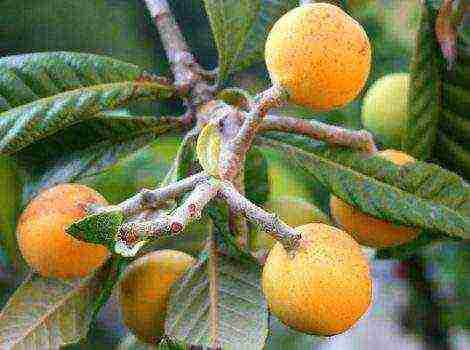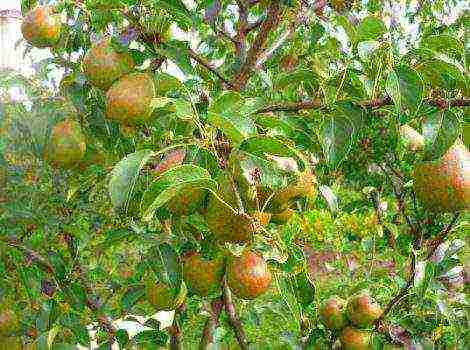Content [show]
How does a peanut grow?
The peanut, or peanut, is a member of the legume family. It belongs to those few plants whose fruits develop and grow underground.... It is considered a valuable oilseed crop and is widely used in the food industry.
Description and history of the origin of peanuts
In appearance, peanuts resemble pods from 1 to 6 cm long. The number of yellowish seeds enclosed in them usually ranges from 1 to 3, the maximum can reach 6 pieces. The seed coat takes on various shades.: deep purple, red, pink or variegated.
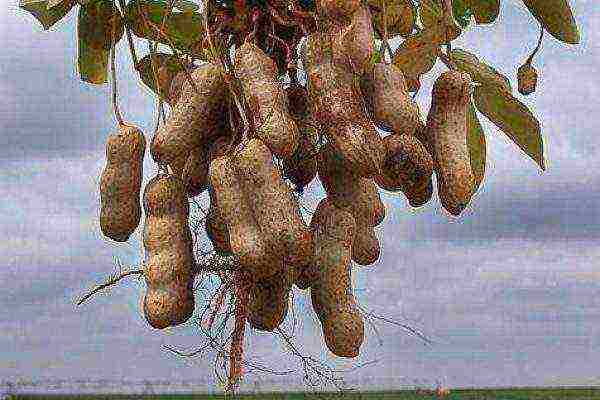
As a result of pollination of flowers and subsequent fertilization, the lower part of the ovary grows. It forms a gynophore - a shoot that penetrates into the moist soil layers and forms a fruit. If the flowers are located more than 20 cm from the ground, then they have no chance of seed formation.
Translated from Greek, peanut means spider. The plant owes its name to the similarity of the mesh pattern on the surface of the pod with cobwebs. BUT due to the way the fruits ripen, peanuts are often called peanuts.
At the end of the 16th century, Portugal established a colony in Canton. The plant ended up in China, where the locals appreciated it. Peanuts helped solve the problem of hunger in the country and is called the Chinese nut.
The next destination was Africa, where he took root well in almost infertile soils. The sowing area of peanuts was growing rapidly, and oilseeds were grown for export.
The massive spread of walnut in the United States began in the 19th century after the Civil War of 1861.... On the advice of the American agrochemist George Carver, farmers alternated crops of peanuts and cotton, which are increasingly dying due to the defeat of the cotton weevil. Soon, walnut yields significantly exceeded cotton revenues and became the main crop in the southern United States.
D. Carver has developed hundreds of varieties of plant products and products. Peanuts are included in the composition of drinks, dyes, cosmetics, medicines.
Russia was able to appreciate all the benefits of culture at the turn of the 18th-19th centuries. The most suitable climatic conditions for growing peanuts are located in the Caucasus, Central Asian republics, in the southern part of Ukraine, in the North Caucasus.
Calorie content and vitamin composition
Peanuts are high in calories: 100 g product contain 551 kcal... People prone to obesity are not advised to get carried away with nuts, especially fried ones.
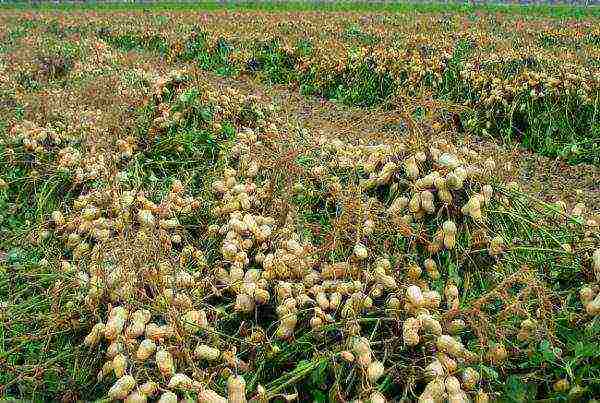
Despite belonging to the legume family, peanuts are closest to nuts in terms of the content of nutrients and vitamins.
The chemical composition includes:
- essential nutrients - proteins (26.3 g / 100 g), fats (45.2 g / 100 g), carbohydrates (9.9 g / 100 g);
- cellulose, sugar, starch;
- vitamin complex (B, C, E, PP);
- micro and macro elements - phosphorus, zinc, iron, copper, calcium, magnesium, manganese, potassium, sodium, selenium.
Useful properties and disadvantages
Experts who have studied the properties of peanuts have come to the conclusion that the benefits and harms of the product are approximately the same.If you take into account the contraindications to use and observe the measure, then unpleasant consequences can be avoided.
The beneficial qualities of peanuts are as follows:
- Proteins and fatscontained in peanuts are easily absorbed by the body. The rich vitamin and elemental composition puts the nut on a par with the products recommended for a healthy diet.
- The presence of linoleic acid reduces the risk of developing multiple sclerosis. With a sufficient content of this important component in the body, the synthesis of essential fatty acids occurs - linolenic and arachidonic. They help maintain normal blood cholesterol levels.
- Peanut fruits increase blood clotting, which reduces blood loss in wounds and in patients with hemophilia.
- Due to the high content of antioxidants, nuts (especially fried ones) are a useful prophylactic agent for heart and vascular diseases. Slows down the aging process and division of cancer cells.
- Natural fiber in peanuts helps to improve digestion, removing pathogenic bacteria from the body.
- Amino acid in peanuts tryptophan produces the hormone serotonin in the body... Its increased content brings people out of depression, restores the nervous system after stress.
- Possesses choleretic action.
- It is a good helper in the fight against infections, boosts immunity.
- With the constant use of fruits in small quantities, people have been noted improvement of hearing, memory, concentration of attention increased.
Products derived from nuts have almost the same beneficial qualities:
- peanut butter preserves the complex of essential vitamins and elements;
- peanut milk has a positive effect on the gastrointestinal tract;
- peanut paste provides the body with energy.
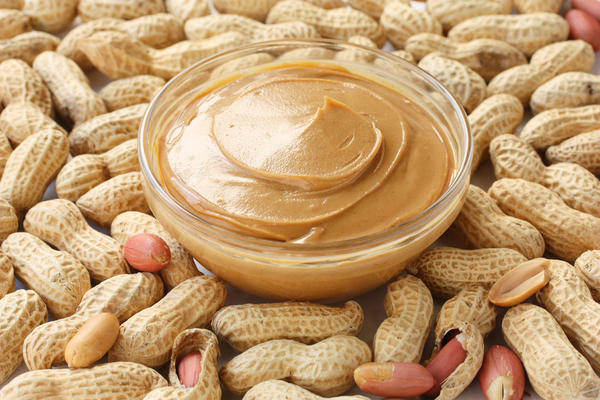
Nut harm:
- Seed shell can provoke allergic reactions, usually expressed by itching and redness of the skin. In rare cases, vomiting, laryngeal edema is possible.
- With joint diseases eating foods high in protein is contraindicated.
- If the technology of seed processing, transportation or storage has been violated, nut can accumulate toxins... Therefore, when buying, be sure to make sure that there is no mold on the shell. Foreign smell is also unacceptable.
- People with varicose veins should not eat peanuts because of their the ability to make blood thicker.
The famous peanut diet raises many questions. On the one hand, the nut promotes the rapid breakdown of fats. On the other side of the scale is the high calorie content of the product.
Application of peanuts
The taste of nuts is familiar to everyone. Fried, salted, sweet, honey-sesame - they can be purchased at any store. In crushed form, peanuts are included in various bakery products, chocolate spreads, halva, creams, coffee drinks.
Most of the crop is processed to make vegetable oil. The highest grade is used in the canning and confectionery industry. The lower grades of peanut butter are used to make high quality Marseilles soaps.
Walnut seed protein is an integral part of various types of glue, plastic... It is used in the production of vegetable wool - ardila.
The tops of the plant are used to feed cattle.
Growing technology
To grow a really high-quality product and reap a rich harvest, you need to strictly follow the recommendations:
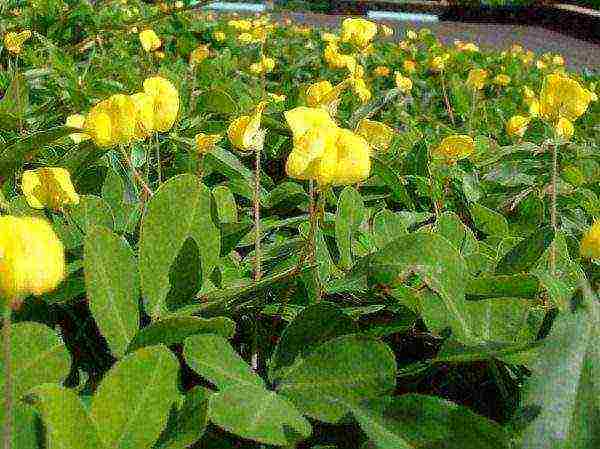
- Presowing soil treatment fertilizers can double the yield. Good lighting and warm soil are essential for peanuts to grow. The optimum temperature for germinating seeds is 25-300C. The lower limit at which their germination is still possible is not lower than 140C.
- Planting is best done in early June.... At this time, the risk of ground frost is minimal. Dried seeds and beans are used for sowing. Gardeners recommend choosing large seeds, otherwise you can not wait for shoots.
- Into a hole deep 7-10 cm (sometimes a little more) put 3-6 pieces nuts, the distance between the sowing rows is not less than a meter. On wet soils, sow peeled seeds 3 cm from the surface.
Given that the nut ripens underground, it is difficult to establish an exact harvest date. On average, this is 3-4 months for early varieties and up to six months for late ones. You can assess the degree of their readiness by tasting a few pieces.
Harvesting peanuts in dry weather... Bushes should be easily pulled out of the ground. When frosts begin on the soil, most of the crop runs the risk of being left underground.
Then the beans are dried in the sun for several weeks and taken away for storage or processing.
Care rules
To get a good harvest, the seedlings need to be looked after.
- To create the necessary moisture groundnuts are watered every 2 weeks... In dry times, this period is halved. Watering is stopped 3-4 weeks before harvesting.
- After the appearance of inflorescences, regular hilling of bushes.
- Mandatory weeding.
- Fertilization at least 3 times during the ripening period. Top dressing can significantly increase yields by reducing the number of underdeveloped beans.

It is not recommended to grow peanuts in the same area more than 2-3 times in a row in order to avoid contamination of the culture with pathogenic organisms that remain in the soil and plant debris.
Conclusion
Peanuts are a unique crop. As a member of legumes, it ripens in the ground like potatoes. Has many benefits as a preventive and therapeutic agent... And the wide scope of application of walnut in various types of industry makes it a versatile product.
